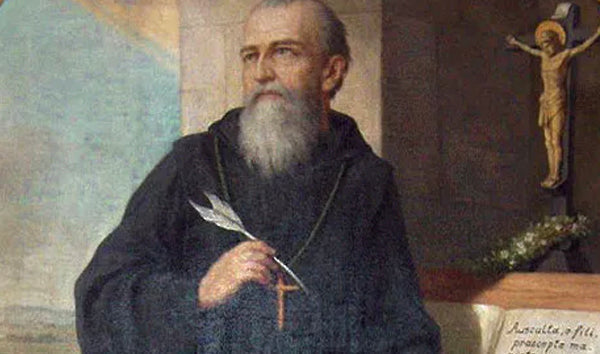
Saint Benedict of Nursia & the Mystical Benedict Medal
|
|
|
|
For the amount of influence that Saint Benedict’s disciples had over Europe, very little is known about the great saint. Many of the details about his early life come from the “Dialogues of Saint Gregory” which are small stories that illustrate miraculous events during his lifetime. These “sketches” are not, however, connected into a cohesive biography.
Gregory’s account of Saint Benedict’s life reportedly came from four of Saint Benedict’s disciples. Saint Benedict was born in the ancient town of Nursia, and had a twin sister, Saint Scholastica. Not much is disclosed about his sister until he was near the end of his life. Saint Benedict was sent to school in Rome by his parents. Upon reaching the city he soon realized that it was full of chaos and sin. Wanting a life of holiness, he retreated to the countryside and lived as a hermit in a cave for about three years. Romanus, a monk who lived in one of the nearby monasteries provided him with food and clothing. Word of sanctity spread, and he was eventually persuaded to become an abbot of one of the monasteries. This decision almost cost him his life.
Saint Benedict has a strong association with exorcism and spiritual protection. Tradition has it that some of the monks in Benedict's own monastery wanted him killed and attempted to poison him. Mystically aware of the plan, Benedict made a Sign of the Cross over the food. Afterwards, the cup of wine shattered and two crows flew in and carried off the poisoned bread.
After the unsuccessful attempt at communal life, Benedict intended to resume his hermit lifestyle. It wasn’t long before his disciples found him in his cave. Benedict then felt compelled to found 12 monasteries with 12 monks a piece. An evil priest tried to ruin Benedict’s soul with slander, attempted murder, and temptation. All these schemes were unsuccessful, but Benedict felt the need to leave the monasteries so that the other monks were not exposed to these acts of evil.
Benedict settled on a steep hill halfway between Rome and Naples. It was called “Monte Cassino.” This time, rather than arranging his monks in different houses, he gathered them under one roof. It was in this period that he most likely established his “rule.” He aimed to provide a “school for the Lord’s Service.” He served the Lord until his death, which he predicted. Six days before the end of his earthly life Benedict instructed his disciples to dig a grave for him. He received the Body and Blood of Christ on his final day. He said a final prayer and died standing on his feet with his hand lifted towards heaven.
Saint Benedict of Nursia wrote "The Benedictine Rule," specifically for his Monks in his own abbey of Monte Cassino. Primarily a book of regulations, it's helpful to think of it as an "employee handbook." "The Rule of St. Benedict" saved the Church in a world gone astray. This book effortlessly combines the practical with the symbolic. Accordingly, in the section "How Monks are to Sleep" Benedict suggests that a lamp be lit to serve as both a "night light" AND the "light of Christ."
The creation date of the St. Benedict Medal isn't known, however, it was formally approved by Pope Benedict XIV in 1741.
The Benedict medal has many versions. The "Jubilee Medal of St. Benedict" has taken the place as the most well-known. Designed in 1880, the medal celebrates the 1400th anniversary of Benedict's birth.


